Physical Simulation of Brittle Rocks by 3D Printing Techniques Considering Cracking Behaviour and Permeability
Abstract
:Featured Application
Abstract
1. Introduction
1.1. Plaster-Based 3D Printing
1.2. Stereolithography 3D Printing
2. Materials and Methods
2.1. 3D Printing Methods
2.1.1. Plaster-Based 3D Printing
2.1.2. Stereolithography 3D Printing
2.2. Moulded Gypsum
2.3. Testing Methods
2.3.1. Uniaxial Compression Strength (UCS) Test
2.3.2. Seepage Test
3. Results
3.1. Mechanical and Fracturing Behaviour of Intact Samples
3.1.1. Mechanical Properties and Failure Mode
3.1.2. Effects of Printing Direction and Sintering Process
- (1)
- Inclination angle
- (2)
- Sintering temperature
- (3)
- Summary
3.2. Mechanical and Fracturing Behaviours of Samples Containing Pre-Existing Flaws
- (1)
- As shown in Table 3, the failure strains of the pre-flawed specimens are significantly higher than those of the intact moulded gypsum (0.1%~0.2%). The double-flawed specimens made from moulded gypsum have a failure strain ranging from 0.7–0.8%, while those made from 3DP gypsum are usually higher than 1%. The higher failure strain of the 3DP specimen is thought to be attributed to the plastic deformation brought on by the binder used in the 3DP process.
- (2)
- The crack patterns of these two types of specimens are similar regardless of flaw geometries. The coalescences appear slightly before the peak stress, and their development induces specimen failure. The result shows the feasibility of the 3DP gypsum in the physical modelling of the rock failure process.
- (3)
- (4)
- The tensile wing cracks, apparently initiating before the anti-wing and coplanar cracks, are more likely to develop in the moulded gypsum specimens than the 3DP samples, which indicates the higher brittleness of the moulded gypsum.
- (5)
- Another obvious difference is that the crack opening of the moulded gypsum is slightly narrower than that of the 3DP gypsum, also indicating the difference in brittleness.
3.3. Seepage Behaviour of SLA Samples
3.3.1. Pore Size and Printing Resolution
3.3.2. Rocks with Coarse Pores
3.4. Printing Resolution Effects
3.4.1. Mathematical Modelling of Permeability
3.4.2. Grain Size and Permeability
3.4.3. Printing Resolution and Permeability
4. Discussion
4.1. Advanced 3D Printing Techniques in Rock Mechanics
- (1)
- Identify the most important physical and mechanical properties of the natural rocks of interest, and then select printing materials and methods.
- (2)
- If multiple physical and mechanical properties are relevant, it may be necessary to consider using a mixture of multiple printing materials or methods, with a discussion of feasibility.
- (3)
- The similarity between artificial and natural samples regarding brittleness or fracture toughness can affect the failure mode.
- (4)
- When exploring the manufacture of rocklike artificial samples, combinations of multiple materials in a single printing sample can be attempted to achieve uniform similarities in strength and deformation.
- (5)
- Advanced 3D printing methods can increase printing resolution and obtain finer pores in samples for research on seepage characteristics.
4.2. Application in Resource Exploitation and Geological Storage
5. Conclusions
- (1)
- SLA is suitable for investigating the seepage characteristics or permeability of natural rocks, while PP can simulate the failure modes of brittle rocks.
- (2)
- The mechanical behaviour and failure modes of PP gypsum samples are similar to those of moulded gypsum samples.
- (3)
- The mechanical properties and failure modes of PP samples are significantly affected by the printing inclination angle and sintering temperature. This can be used to simulate sedimentary rocks by studying the influence of sedimentary orientation and cementation conditions.
- (4)
- The slight difference in mechanical properties from previously published data highlights the importance of verification tests before each physical simulation using 3D printing methods.
- (5)
- The SLA 3DP samples are found to have the capability to simulate the permeability coefficient and the anisotropy of porous basalts.
Author Contributions
Funding
Institutional Review Board Statement
Informed Consent Statement
Data Availability Statement
Conflicts of Interest
References
- IEA. Special Report on Carbon Capture Utilisation and Storage: CCUS in Clean Energy Transitions; International Energy Agency: Paris, France, 2020. [Google Scholar]
- Ringrose, P. How to Store CO2 Underground: Insights from Early-Mover CCS Projects, 1st ed.; Springer International Publishing: Cham, Switzerland; Imprint: Hatfield, PA, USA, 2020. [Google Scholar]
- Sun, L.; Dou, H.; Li, Z.; Hu, Y.; Hao, X. Assessment of CO2 storage potential and carbon capture, utilization and storage prospect in China. J. Energy Inst. 2018, 91, 970–977. [Google Scholar] [CrossRef]
- Gluyas, J.; Mathias, S. Geological Storage of Carbon Dioxide (CO2): Geoscience, Technologies, Environmental Aspects and Legal Frameworks; Woodhead Pub.: Philadelphia, PA, USA, 2013. [Google Scholar]
- Yin, Q.; Liu, R.; Jing, H.; Su, H.; Yu, L.; He, L. Experimental Study of Nonlinear Flow Behaviors Through Fractured Rock Samples After High-Temperature Exposure. Rock Mech. Rock Eng. 2019, 52, 2963–2983. [Google Scholar] [CrossRef]
- Jiang, C.; Zhao, G.-F. A preliminary study of 3D printing on rock mechanics. Rock Mech. Rock Eng. 2015, 48, 1041–1050. [Google Scholar] [CrossRef]
- Zhou, T.; Zhu, J. Mechanical and volumetric fracturing behaviour of three-dimensional printing rocklike samples under dynamic loading. Rock Mech. Rock Eng. 2020, 53, 2855–2864. [Google Scholar] [CrossRef]
- Sharafisafa, M.; Shen, L. Experimental investigation of dynamic fracture patterns of 3D printed rocklike material under impact with digital image correlation. Rock Mech. Rock Eng. 2020, 53, 3589–3607. [Google Scholar] [CrossRef]
- Zhou, T.; Zhu, J.B.; Ju, Y.; Xie, H.P. Volumetric fracturing behavior of 3D printed artificial rocks containing single and double 3D internal flaws under static uniaxial compression. Eng. Fract. Mech. 2019, 205, 190–204. [Google Scholar] [CrossRef]
- Sharafisafa, M.; Shen, L.; Zheng, Y.; Xiao, J. The effect of flaw filling material on the compressive behaviour of 3D printed rocklike discs. Int. J. Rock Mech. Min. Sci. 2019, 117, 105–117. [Google Scholar] [CrossRef]
- Zhu, J.B.; Zhou, T.; Liao, Z.Y.; Sun, L.; Li, X.B.; Chen, R. Replication of internal defects and investigation of mechanical and fracture behaviour of rock using 3D printing and 3D numerical methods in combination with X-ray computerized tomography. Int. J. Rock Mech. Min. Sci. 2018, 106, 198–212. [Google Scholar] [CrossRef]
- Zhou, T.; Zhu, J.B. Identification of a suitable 3D printing material for mimicking brittle and hard rocks and its brittleness enhancements. Rock Mech. Rock Eng. 2018, 51, 765–777. [Google Scholar] [CrossRef]
- Ju, Y.; Wang, L.; Xie, H.; Ma, G.; Mao, L.; Zheng, Z.; Lu, J. Visualization of the three-dimensional structure and stress field of aggregated concrete materials through 3D printing and frozen-stress techniques. Constr. Build. Mater. 2017, 143, 121–137. [Google Scholar] [CrossRef]
- Gomez, J.S.; Chalaturnyk, R.J.; Zambrano-Narvaez, G. Experimental investigation of the mechanical behavior and permeability of 3D printed sandstone analogues under triaxial conditions. Transp. Porous Media 2019, 129, 541–557. [Google Scholar] [CrossRef]
- Guo, C.; Zhao, D.; Liu, Z.; Ding, Q.; Gao, H.; Yan, Q.; Sun, Y.; Ren, F. The 3D-printed honeycomb metamaterials tubes with tunable negative poisson’s ratio for high-performance static and dynamic mechanical properties. Materials 2021, 14, 1353. [Google Scholar] [CrossRef] [PubMed]
- Montazerian, H.; Mohamed, M.G.A.; Montazeri, M.M.; Kheiri, S.; Milani, A.S.; Kim, K.; Hoorfar, M. Permeability and mechanical properties of gradient porous PDMS scaffolds fabricated by 3D-printed sacrificial templates designed with minimal surfaces. Acta Biomater. 2019, 96, 149–160. [Google Scholar] [CrossRef] [PubMed]
- Hasiuk, F.J. Testing bulk properties of powder-based 3D-printed reservoir rock proxies. Transp. Porous Media 2019, 129, 501–520. [Google Scholar] [CrossRef]
- Song, L.; Jiang, Q.; Shi, Y.-E.; Feng, X.-T.; Li, Y.; Su, F.; Liu, C. Feasibility investigation of 3D printing technology for geotechnical physical models: Study of tunnels. Rock Mech. Rock Eng. 2018, 51, 2617–2637. [Google Scholar] [CrossRef]
- Jiang, C.; Zhao, G.-F.; Zhu, J.; Zhao, Y.-X.; Shen, L. Investigation of dynamic crack coalescence using a gypsum-like 3D printing material. Rock Mech. Rock Eng. 2016, 49, 3983–3998. [Google Scholar] [CrossRef]
- Fereshtenejad, S.; Song, J.-J. Fundamental study on applicability of powder-based 3D printer for physical modeling in rock mechanics. Rock Mech. Rock Eng. 2016, 49, 2065–2074. [Google Scholar] [CrossRef]
- Bobby, S.S.; Singamneni, S. Influence of moisture in the gypsum moulds made by 3D printing. Procedia Eng. 2014, 97, 1618–1625. [Google Scholar] [CrossRef]
- Shao, Y.; Yang, J.; Kim, J.; Song, J.-J.; Moon, J.; Han, J. A Comprehensive Experimental Study on Mechanical Anisotropy and Failure Mode of 3D Printed Gypsum Rocks: From Composition and Microstructure to Macroscopic Mechanical Properties Response. Rock Mech. Rock Eng. 2023, 56, 6503–6528. [Google Scholar] [CrossRef]
- Niu, Q.; Jiang, L.; Li, C.; Zhao, Y.; Wang, Q.; Yuan, A. Application and prospects of 3D printing in physical experiments of rock mass mechanics and engineering: Materials, methodologies and models. Int. J. Coal Sci. Technol. 2023, 10, 5. [Google Scholar] [CrossRef]
- Ishutov, S.; Hasiuk, F.J.; Harding, C.; Gray, J.N. 3D printing sandstone porosity models. Interpretation 2015, 3, SX49–SX61. [Google Scholar] [CrossRef]
- Ozelim, L.C.d.S.M.; Cavalcante, A.L.B. Combining microtomography, 3D printing, and numerical simulations to study scale effects on the permeability of porous media. Int. J. Geomech. 2019, 19, 04018194. [Google Scholar] [CrossRef]
- Head, D.; Vanorio, T. Effects of changes in rock microstructures on permeability: 3-D printing investigation. Geophys. Res. Lett. 2016, 43, 7494–7502. [Google Scholar] [CrossRef]
- Ju, Y.; Gong, W.; Zheng, J. Effects of pore topology on immiscible fluid displacement: Pore-scale lattice Boltzmann modelling and experiments using transparent 3D printed models. Int. J. Multiphase Flow 2022, 152, 104085. [Google Scholar] [CrossRef]
- Kong, L.; Ostadhassan, M.; Liu Bo, L.B.; Eshraghi, M.; Li Chunxiao, L.C.; Navarro, M.; Zhang Yihuai, Z.Y.; Wei Huabin, W.H. A comparison of three-dimensional-printed porous rocks with nano X-ray computed tomography silica sand, gypsum powder, and resin. AAPG Bull. 2021, 105, 2245–2261. [Google Scholar] [CrossRef]
- Tan, W.; Wang, P. Experimental study on seepage properties of jointed rocklike samples based on 3D printing techniques. Adv. Civ. Eng. 2020, 2020, 10. [Google Scholar] [CrossRef]
- Ishutov, S. Establishing Framework for 3D Printing Porous Rock Models in Curable Resins. Transp. Porous Media 2019, 129, 431–448. [Google Scholar] [CrossRef]
- Almetwally, A.G.; Jabbari, H. 3D-Printing Replication of Porous Media for Lab-Scale Characterization Research. ACS Omega 2021, 6, 2655–2664. [Google Scholar] [CrossRef]
- Fahim Salek, M.; Shinde, V.V.; Beckingham, B.S.; Beckingham, L.E. Resin based 3D printing for fabricating reactive porous media. Mater. Lett. 2022, 322, 132469. [Google Scholar] [CrossRef]
- Song, R.; Wang, Y.; Sun, S.; Liu, J. Characterization and microfabrication of natural porous rocks: From micro-CT imaging and digital rock modelling to micro-3D-printed rock analogs. J. Pet. Sci. Eng. 2021, 205, 108827. [Google Scholar] [CrossRef]
- Goral, J.; Deo, M. Nanofabrication of synthetic nanoporous geomaterials: From nanoscale-resolution 3D imaging to nano-3D-printed digital (shale) rock. Sci. Rep. 2020, 10, 21596. [Google Scholar] [CrossRef] [PubMed]
- Zhang, K.; Zhang, K.; Ye, J.; Liu, X.; Fan, W. An improved sand 3D printing method for better reproduction of high-strength and high-brittleness rock mechanical properties is proposed. J. Mater. Res. Technol. 2023, 26, 5037–5054. [Google Scholar] [CrossRef]
- Ma, S.; Jin, G.; Antle, R.; Wieneke, B. 3D Printed Rocks—An Emerging Technology for Systematic Petrophysical Studies. In Proceedings of the Middle East Oil, Gas and Geosciences Show, Manama, Bahrain, 19–21 February 2023. [Google Scholar]
- Osei-Bonsu, K.; Grassia, P.; Shokri, N. Effects of pore geometry on flowing foam dynamics in 3D-printed porous media. Transp. Porous Media 2018, 124, 903–917. [Google Scholar] [CrossRef]
- Wei, D.; Wang, Z.; Pereira, J.-M.; Gan, Y. Permeability of uniformly graded 3D printed granular media. Geophys. Res. Lett. 2021, 48, 1–12. [Google Scholar] [CrossRef]
- Kondo, A.; Matsumura, S.; Mizutani, T.; Kohama, E. Reproduction of discrete element model by 3D printing and its experimental validation on permeability issue. In Proceedings of the Advances in Laboratory Testing and Modelling of Soils and Shales (ATMSS), Cham, Switzerland, 18–20 January 2017; pp. 517–524. [Google Scholar]
- Kafle, A.; Luis, E.; Raman, S.; Pan, H.M.; Pratisthit Lal, S.; Bastola, A.K. 3D/4D printing of polymers: Fused deposition modelling (FDM), selective laser sintering (SLS), and stereolithography (SLA). Polymers 2021, 13, 3101. [Google Scholar] [CrossRef] [PubMed]
- Kong, L.; Ostadhassan, M.; Li, C.; Tamimi, N. Can 3-D printed gypsum samples replicate natural rocks? an experimental study. Rock Mech. Rock Eng. 2018, 51, 3061–3074. [Google Scholar] [CrossRef]
- Kong, L.; Ostadhassan, M.; Li, C.; Tamimi, N. Pore characterization of 3D-printed gypsum rocks: A comprehensive approach. J. Mater. Sci. 2018, 53, 5063–5078. [Google Scholar] [CrossRef]
- Zou, C.; Wong, L.N.Y.; Cheng, Y. The strength and crack behavior of the rocklike gypsum under high strain rate. In Proceedings of the 46th US Rock Mechanics/Geomechanics Symposium 2012, Chicago, IL, USA, 24–27 June 2012; pp. 1773–1786. [Google Scholar]
- Zou, C.; Wong, L.N.Y. Different compressive and tensile strength of moulded gypsum under various strain rates from quasi-static to dynamic regime. Geotech. Test. J. 2016, 39, 20150174. [Google Scholar] [CrossRef]
- Wong, L.; Jong, M. Water saturation effects on the Brazilian tensile strength of gypsum and assessment of cracking processes using high-speed video. Rock Mech. Rock Eng. 2014, 47, 1103–1115. [Google Scholar] [CrossRef]
- Zou, C.; Wong, L.N.Y.; Loo, J.J.; Gan, B.S. Different mechanical and cracking behaviors of single-flawed brittle gypsum specimens under dynamic and quasi-static loadings. Eng. Geol. 2016, 201, 71–84. [Google Scholar] [CrossRef]
- Zhang, G.; Wang, M.; Li, X.; Yue, S.; Wen, Z.; Han, S. Micro- and macrocracking behaviors in granite and molded gypsum containing a single flaw. Constr. Build. Mater. 2021, 292, 123452. [Google Scholar] [CrossRef]
- Zhou, T.; Zhu, J. An experimental investigation of tensile fracturing behavior of natural and artificial rocks in static and dynamic brazilian disc tests. Procedia Eng. 2017, 191, 992–998. [Google Scholar] [CrossRef]
- Heidari, M.; Khanlari, G.R.; Torabi Kaveh, M.; Kargarian, S. Predicting the uniaxial compressive and tensile strengths of gypsum rock by point load testing. Rock Mech. Rock Eng. 2012, 45, 265–273. [Google Scholar] [CrossRef]
- Brantut, N.; Schubnel, A.; Guéguen, Y. Damage and rupture dynamics at the brittle-ductile transition: The case of gypsum. J. Geophys. Res. Solid Earth 2011, 116, 1–19. [Google Scholar] [CrossRef]
- Wong, L.N.Y.; Einstein, H.H. Crack coalescence in molded gypsum and carrara marble: Part 1. macroscopic observations and interpretation. Rock Mech. Rock Eng. 2009, 42, 475–511. [Google Scholar] [CrossRef]
- Heard, H.C.; Griggs, D.; Handin, J. Chapter 7: Transition from brittle fracture to ductile flow in solenhofen limestone as a function of temperature, confining pressure, and interstitial fluid pressure. In Rock Deformation (A Symposium); Geological Society of America: Boulder, CO, USA, 1960; Volume 79. [Google Scholar]
- Zou, C.; Yingying, S.; Liu, K.; Cheng, Y.; Li, J. Feasibility of artificial materials in simulating rock failure based on rate-dependent brittleness indexes. Rock Mech. Rock Eng. 2022, 55, 4999–5027. [Google Scholar] [CrossRef]
- Liu, L.; Li, H.; Chen, S.; Shao, Z.; Zhou, C.; Fu, S. Effects of bedding planes on mechanical characteristics and crack evolution of rocks containing a single pre-existing flaw. Eng. Geol. 2021, 293, 106325. [Google Scholar] [CrossRef]
- Liu, H.; Jing, H.; Yin, Q.; Meng, Y.; Zhu, G. Effect of bedding plane on mechanical properties, failure mode, and crack evolution characteristic of bedded rocklike specimen. Theor. Appl. Fract. Mech. 2023, 123, 103681. [Google Scholar] [CrossRef]
- Zhu, Y.; Liu, K.; Zhong, X.; Wang, Y.; Chen, C.; Zhang, H.; Pan, D.; Zhai, L.; Gao, S. Experimental investigation on the anisotropic behaviors induced by bedding planes in mechanical properties of Ma′quan oil shale. Arab. J. Sci. Eng. 2022, 47, 11385–11403. [Google Scholar] [CrossRef]
- Zhao, Y.; Semnani, S.J.; Yin, Q.; Borja, R.I. On the strength of transversely isotropic rocks. Int. J. Numer. Anal. Methods Geomech. 2018, 42, 1917–1934. [Google Scholar] [CrossRef]
- Liu, Y.; Tang, H. Rockmass Mechanics; China University of Geosciences Press: Wuhan, China, 1999; p. 214. [Google Scholar]
- Jiang, Q.; Feng, X.; Song, L.; Gong, Y.; Zheng, H.; Cui, J. Modeling rock specimens through 3D printing: Tentative experiments and prospects. Acta Mech. Sin. 2016, 32, 101–111. [Google Scholar] [CrossRef]
- Liu, H.; Zhao, Y.; Jiang, Y.; Wang, Z. Technology. Experimental study of mechanical properties of 3D printing gypsum specimens. Mech. Eng. 2017, 39, 455–459. [Google Scholar]
- Yin, P.; Wong, R.H.C.; Chau, K.T. Coalescence of two parallel pre-existing surface cracks in granite. Int. J. Rock Mech. Min. Sci. 2014, 68, 66–84. [Google Scholar] [CrossRef]
- Yang, L.; Jiang, Y.; Li, S.; Li, B. Experimental and numerical research on 3D crack growth in rocklike material subjected to uniaxial tension. J. Geotech. Geoenviron. Eng. 2013, 139, 1781–1788. [Google Scholar] [CrossRef]
- Lee, H.; Jeon, S. An experimental and numerical study of fracture coalescence in pre-cracked specimens under uniaxial compression. Int. J. Solids Struct. 2011, 48, 979–999. [Google Scholar] [CrossRef]
- Park, C.H.; Bobet, A. Crack initiation, propagation and coalescence from frictional flaws in uniaxial compression. Eng. Fract. Mech. 2010, 77, 2727–2748. [Google Scholar] [CrossRef]
- Sagong, M.; Bobet, A. Coalescence of multiple flaws in a rock-model material in uniaxial compression. Int. J. Rock Mech. Min. Sci. 2002, 39, 229–241. [Google Scholar] [CrossRef]
- Einstein, H.H.; Stephansson, O. Fracture systems, fracture propagation and coalescence. In Proceedings of the Geoeng2000-An International Conference on Geotechnical & Geological Engineering, Melbourne, Australia, 19–24 November 2000; pp. 1–41. [Google Scholar]
- Wong, R.H.C.; Chau, K.T. Crack coalescence in a rocklike material containing two cracks. Int. J. Rock Mech. Min. Sci. 1998, 35, 147–164. [Google Scholar] [CrossRef]
- Wong, L.N.Y.; Einstein, H.H. Coalescence behavior in Carrara marble and molded gypsum containing artificial flaw pairs under uniaxial compression. In Proceedings of the 1st Canada-US Rock Mechanics Symposium—Rock Mechanics Meeting Society’s Challenges and Demands, Vancouver, BC, Canada, 27–31 May 2007; pp. 581–589. [Google Scholar]
- Kovacich, J.R.; Haimson, B.C. Factors affecting borehole breakout dimensions, and the potential for sand production in high porosity berea sandstone. In Proceedings of the 4th North American Rock Mechanics Symposium, Seattle, WA, USA, 31 July–3 August 2000. [Google Scholar]
- Grasmueck, M.; Marchesini, P.; Eberli, G.; Zeller, M.; Van Dam, R. 4D GPR tracking of water infiltration in fractured high-porosity limestone. In Proceedings of the XIII Internarional Conference on Ground Penetrating Radar, Lecce, Italy, 21–25 June 2010. [Google Scholar]
- Yan, S.; Zhang, F.; Wang, S.; He, P.; Jia, D.; Yang, J. Crystallization behavior and mechanical properties of high open porosity dolomite hollow microspheres filled hybrid geopolymer foams. Cem. Concr. Compos. 2019, 104, 103376. [Google Scholar] [CrossRef]
- Al-Harthi, A.A.; Al-Amri, R.M.; Shehata, W.M. The porosity and engineering properties of vesicular basalt in Saudi Arabia. Eng. Geol. 1999, 54, 313–320. [Google Scholar] [CrossRef]
- Badawy, A.M.; Ganat, T.A.A.O. Permeability; Springer International Publishing: Cham, Switzerland, 2021; pp. 35–56. [Google Scholar]
- Zhang, L. Chapter 8—Permeability. In Engineering Properties of Rocks, 2nd ed.; Zhang, L., Ed.; Butterworth-Heinemann: Woburn, MA, USA, 2017; pp. 339–370. [Google Scholar]
- Bear, J. Hydraulic conductivity of isotropic media. In Dynamics of Fluids in Porous Media; Bear, J., Ed.; Dover Publications: New York, NY, USA, 1972; pp. 119–156. [Google Scholar]
- Huang, Z.; Shao, G.; Li, L. Micro/nano functional devices fabricated by additive manufacturing. Prog. Mater. Sci. 2023, 131, 101020. [Google Scholar] [CrossRef]
- Xu, W.; Jambhulkar, S.; Ravichandran, D.; Zhu, Y.; Kakarla, M.; Nian, Q.; Azeredo, B.; Chen, X.; Jin, K.; Vernon, B.; et al. 3D printing-enabled nanoparticle alignment: A review of mechanisms and applications. Small 2021, 17, 2100817. [Google Scholar] [CrossRef] [PubMed]
- Worden, R.; Armitage, P.; Butcher, A.; Churchill, J.; Csoma, A.; Hollis, C.; Lander, R.; Omma, J. Petroleum reservoir quality prediction: Overview and contrasting approaches from sandstone and carbonate communities. Geol. Soc. Lond. Spec. Publ. 2018, 435, 1–31. [Google Scholar] [CrossRef]
- Feng, X.; Peng, X.; Li, L.; Yang, X.; Wang, J.; Li, Q.; Zhang, C.; Deng, H. Influence of reservoir heterogeneity on water invasion differentiation in carbonate gas reservoirs. Nat. Gas Ind. B 2019, 6, 7–15. [Google Scholar] [CrossRef]
- Callow, B.; Falcon-Suarez, I.; Ahmed, S.; Matter, J. Assessing the carbon sequestration potential of basalt using X-ray micro-CT and rock mechanics. Int. J. Greenhouse Gas Control 2018, 70, 146–156. [Google Scholar] [CrossRef]
- Rutqvist, J. The geomechanics of CO2 storage in deep sedimentary formations. Geotech. Geol. Eng. 2012, 30, 525–551. [Google Scholar] [CrossRef]
- Niemi, A.; Bear, J.; Bensabat, J. Geological Storage of CO2 in Deep Saline Formations; Springer: Dordrecht, The Netherlands, 2017; Volume 29. [Google Scholar]
- Saini, D. Engineering Aspects of Geologic CO2 Storage: Synergy between Enhanced Oil Recovery and Storage; Springer International Publishing AG: Cham, Switzerland, 2017. [Google Scholar]
- Ringrose, P.; Bentley, M. Reservoir Model Design: A Practitioner’s Guide; Springer International Publishing AG: Cham, Switzerland, 2021. [Google Scholar]
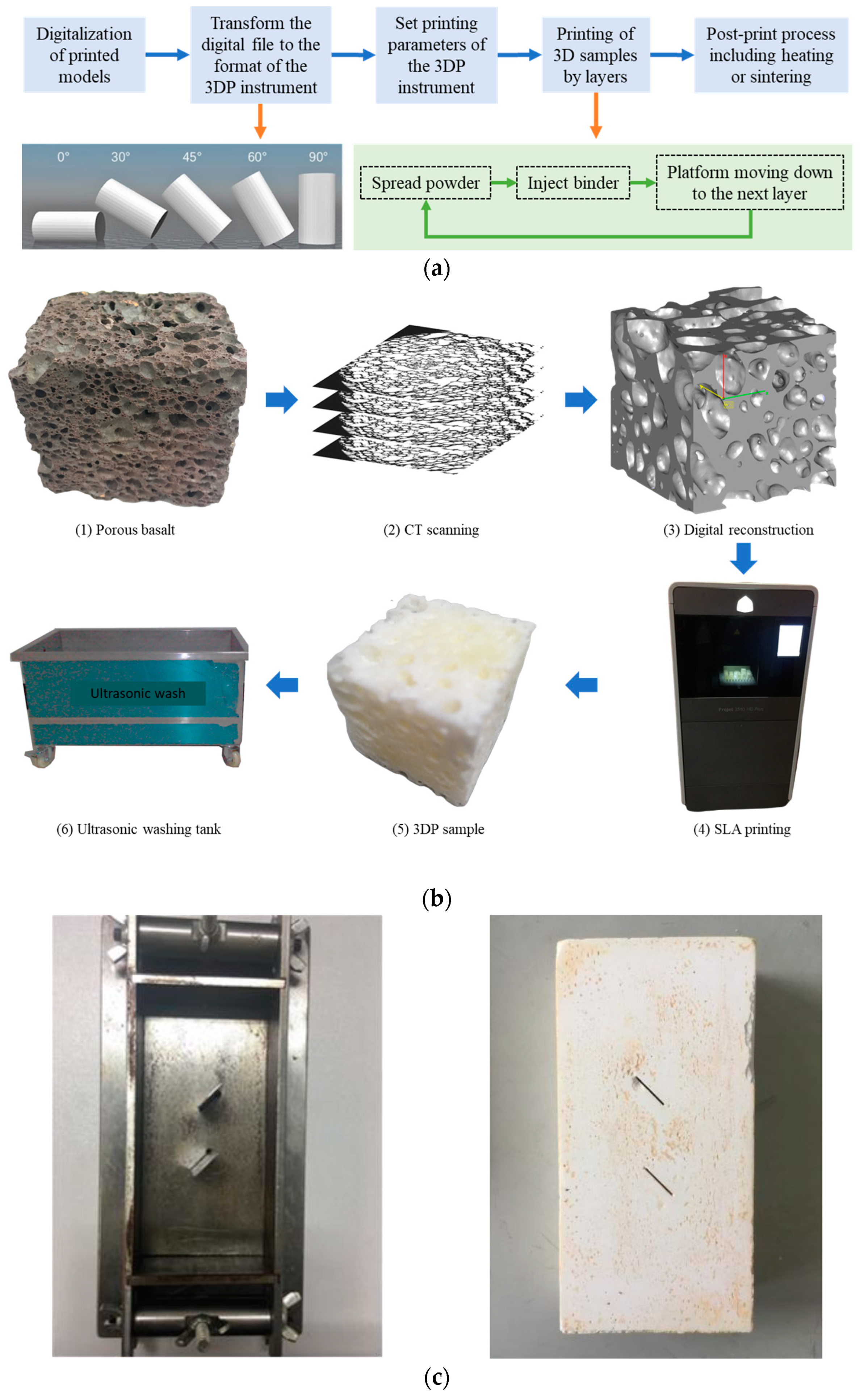

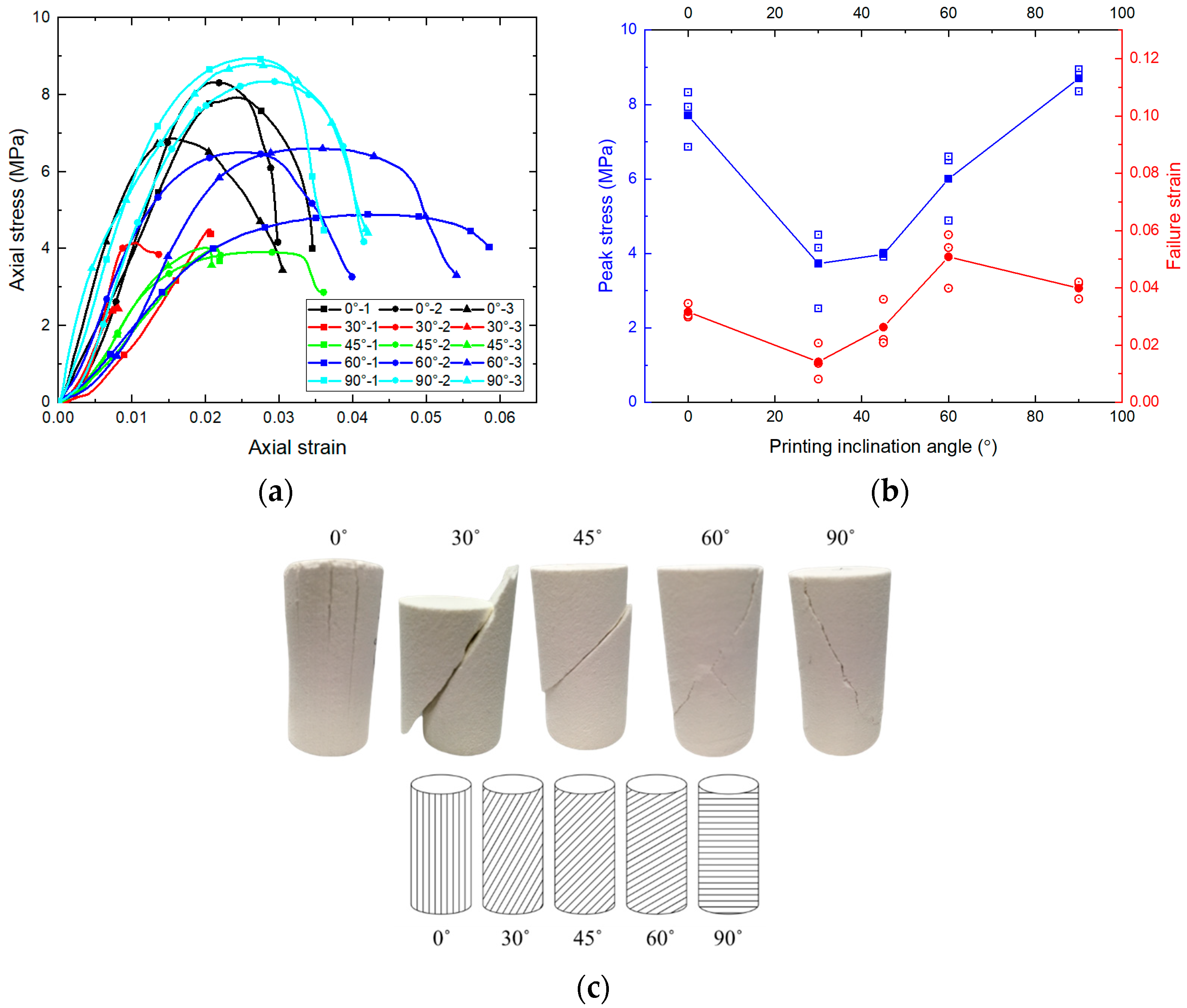

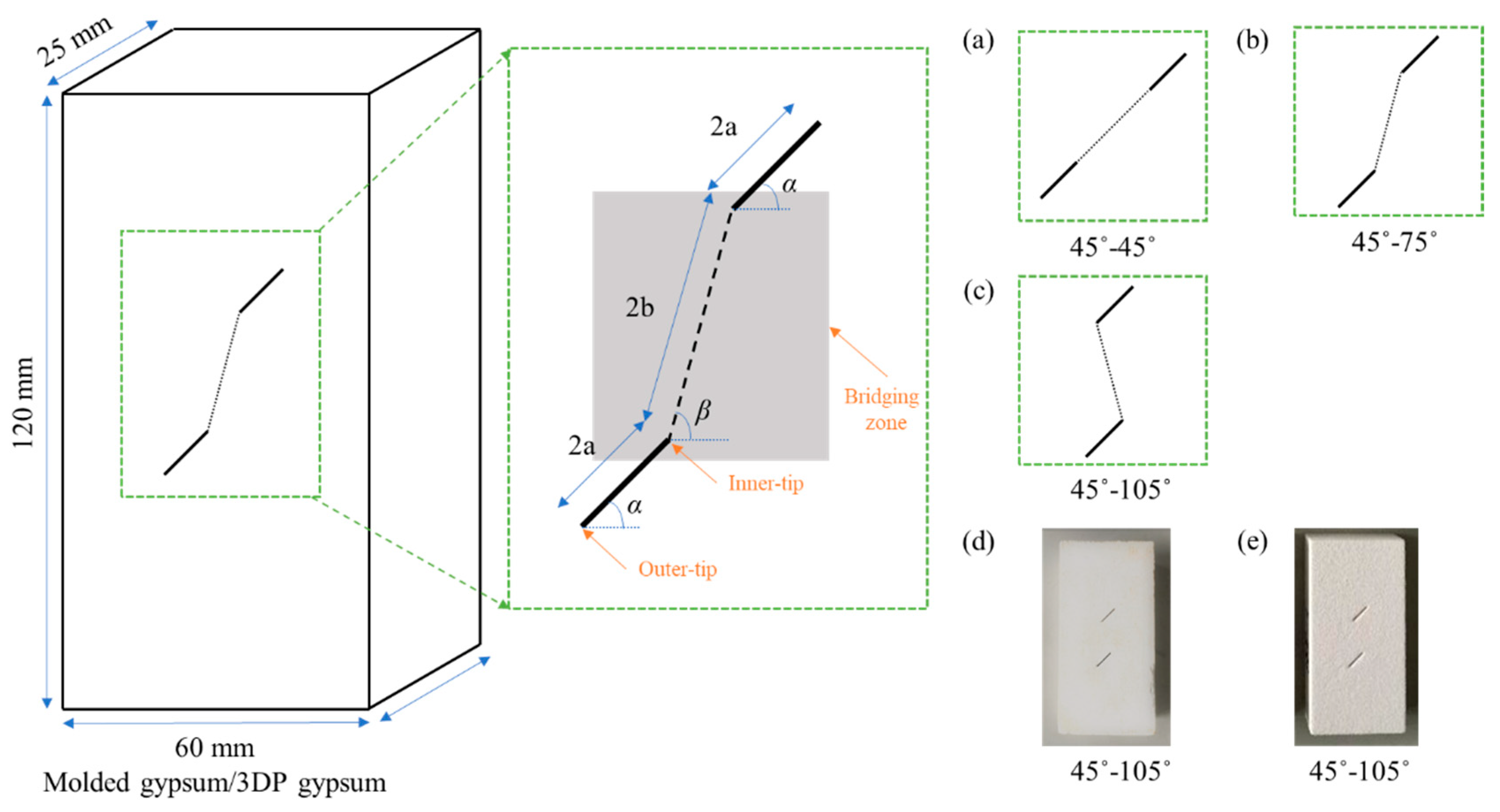



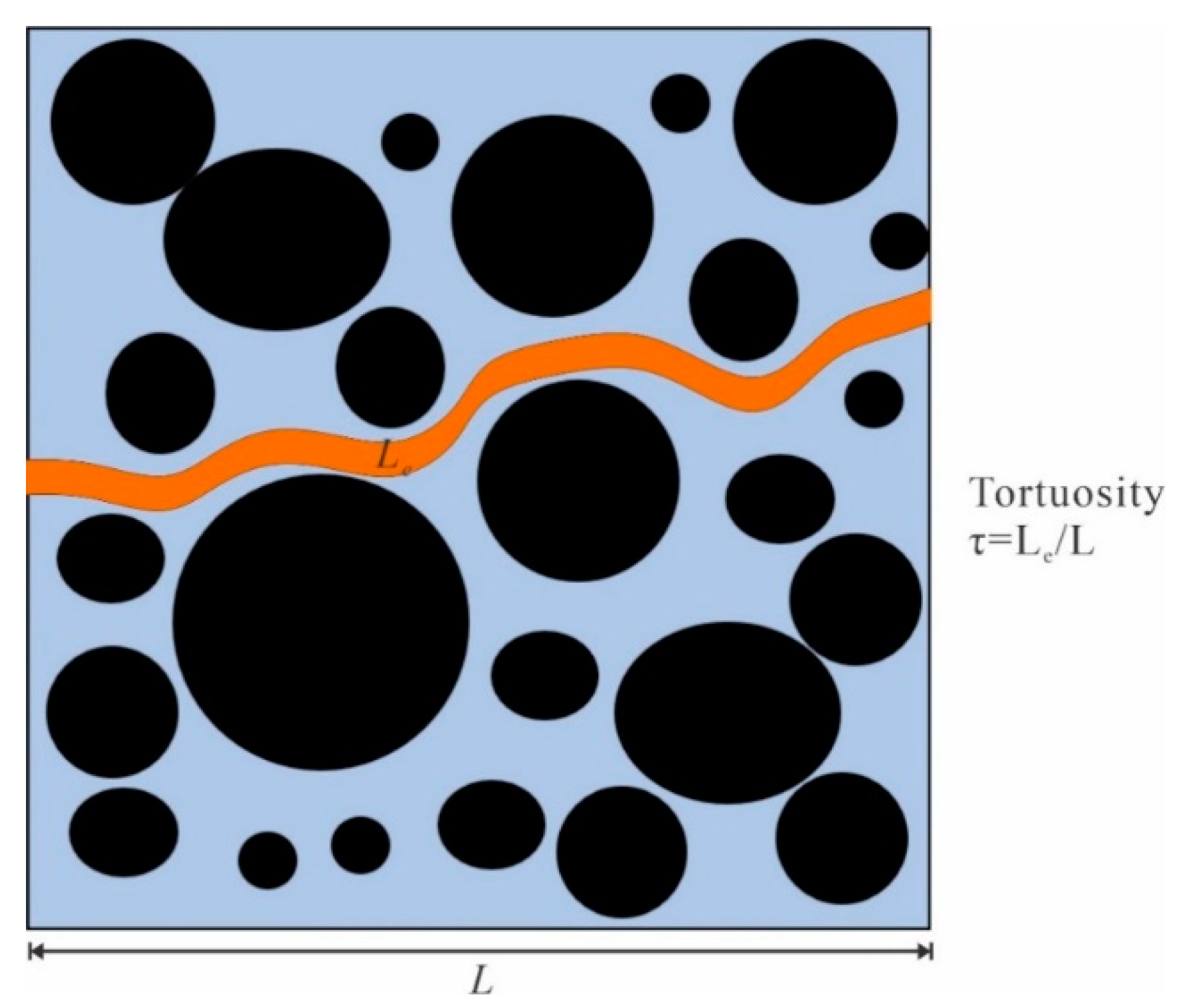

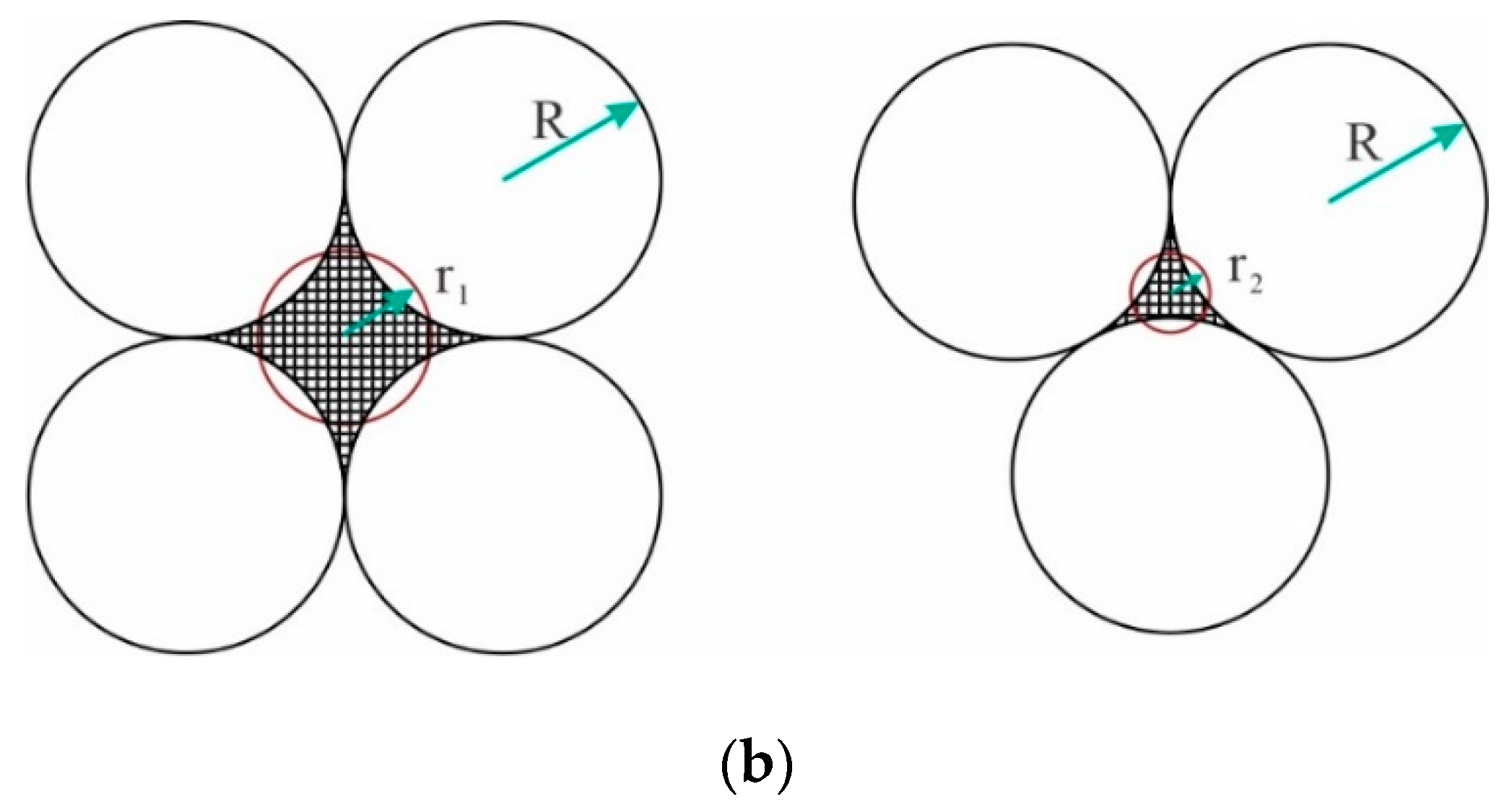


| Inclination Angle | Density (g/cm3) | UCS (MPa) | Failure Strain |
|---|---|---|---|
| 0° | 1.24 | 7.7 | 2.0% |
| 30° | 1.23 | 4.2 | 1.6% |
| 45° | 1.22 | 3.9 | 2.3% |
| 60° | 1.23 | 6.0 | 3.4% |
| 90° | 1.25 | 8.6 | 2.8% |
| Sintering Temperature (°C) | Dry Density (g/cm3) | UCS (MPa) | Failure Strain |
|---|---|---|---|
| 20 | 1.29 | 2.7 | 4.3% |
| 60 | 1.26 | 5.2 | 3.0% |
| 100 | 1.25 | 8.6 | 2.8% |
| 140 | 1.22 | 4.4 | 3.3% |
| Flaw Geometry | Moulded Gypsum | 3DP Gypsum | ||
|---|---|---|---|---|
| UCS (MPa) | Failure Strain | UCS (MPa) | Failure Strain | |
| 45°–45° | 28.1 | 0.68% | 5.6 | 1.24% |
| 45°–75° | 25.9 | 0.71% | 4.9 | 1.17% |
| 45°–105° | 27.1 | 0.75% | 6.1 | 1.43% |
| Specimen No. | Porosity (%) | Average Porosity (%) | Seepage Face | K (10−4 cm/s) | Average K (10−4 cm/s) |
|---|---|---|---|---|---|
| Origin | 25.41 | 25.41 | A | 3.13 | 3.13 |
| 1 | 22.97 | 24.90 | A | 2.74 | 2.77 |
| 2 | 27.78 | 2.91 | |||
| 3 | 23.96 | 2.66 | |||
| 4 | 23.85 | 23.10 | B | 5.34 | 5.11 |
| 5 | 22.30 | 5.13 | |||
| 6 | 23.14 | 4.87 | |||
| 7 | 23.86 | 23.24 | C | 9.85 | 10.28 |
| 8 | 22.73 | 10.75 | |||
| 9 | 23.12 | 10.23 |
| Particle Size/nm | Printing Technique | Permeability/mD | Corresponding Rock |
|---|---|---|---|
| 10 | TPP | 0.000733 | Fresh granite |
| 100 | EHD jet printing and ECAM | 0.073297 | Fresh limestone and dolomite |
| 1000 | μSLA, PμSL, DIW, and Micro-SLS | 7.329714 | Fresh sandstone |
| 10,000 | CLIP, Micro-CAL, AJ deposition, and Micro-SLM | 732.9714 | Oil reservoir rocks |
| 100,000 | FDM | 73,297.14 | Highly fractured rocks |
| 1,000,000 | Most | 7,329,714 | Highly fractured rocks |
Disclaimer/Publisher’s Note: The statements, opinions and data contained in all publications are solely those of the individual author(s) and contributor(s) and not of MDPI and/or the editor(s). MDPI and/or the editor(s) disclaim responsibility for any injury to people or property resulting from any ideas, methods, instructions or products referred to in the content. |
© 2023 by the authors. Licensee MDPI, Basel, Switzerland. This article is an open access article distributed under the terms and conditions of the Creative Commons Attribution (CC BY) license (https://creativecommons.org/licenses/by/4.0/).
Share and Cite
Zhao, X.; Liu, Y.; Zou, C.; He, L.; Che, P.; Li, J. Physical Simulation of Brittle Rocks by 3D Printing Techniques Considering Cracking Behaviour and Permeability. Appl. Sci. 2024, 14, 344. https://doi.org/10.3390/app14010344
Zhao X, Liu Y, Zou C, He L, Che P, Li J. Physical Simulation of Brittle Rocks by 3D Printing Techniques Considering Cracking Behaviour and Permeability. Applied Sciences. 2024; 14(1):344. https://doi.org/10.3390/app14010344
Chicago/Turabian StyleZhao, Xiaobao, Yang Liu, Chunjiang Zou, Lei He, Ping Che, and Jianchun Li. 2024. "Physical Simulation of Brittle Rocks by 3D Printing Techniques Considering Cracking Behaviour and Permeability" Applied Sciences 14, no. 1: 344. https://doi.org/10.3390/app14010344
APA StyleZhao, X., Liu, Y., Zou, C., He, L., Che, P., & Li, J. (2024). Physical Simulation of Brittle Rocks by 3D Printing Techniques Considering Cracking Behaviour and Permeability. Applied Sciences, 14(1), 344. https://doi.org/10.3390/app14010344






